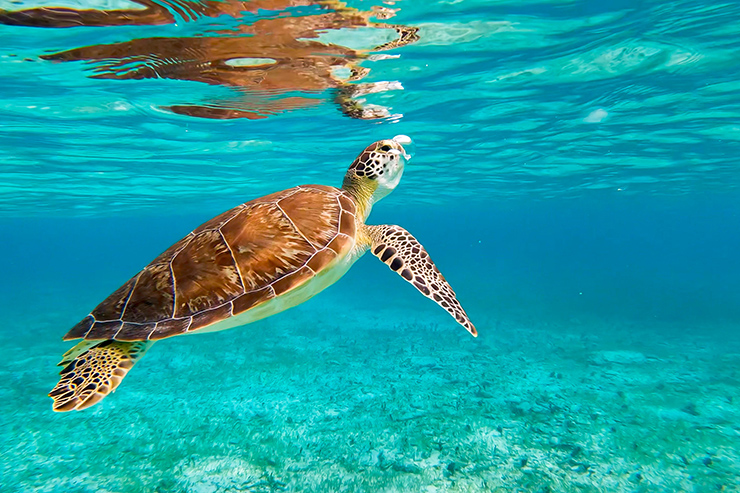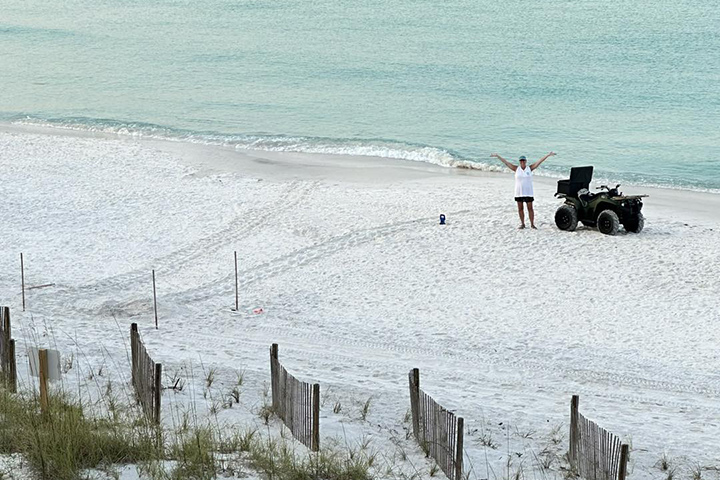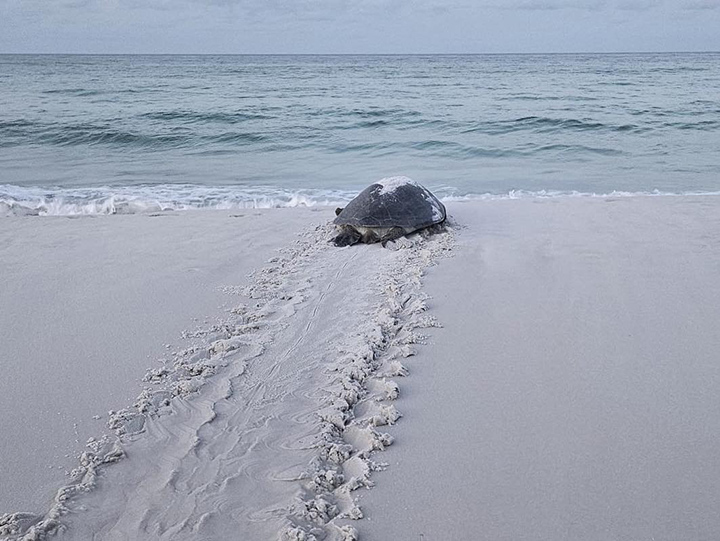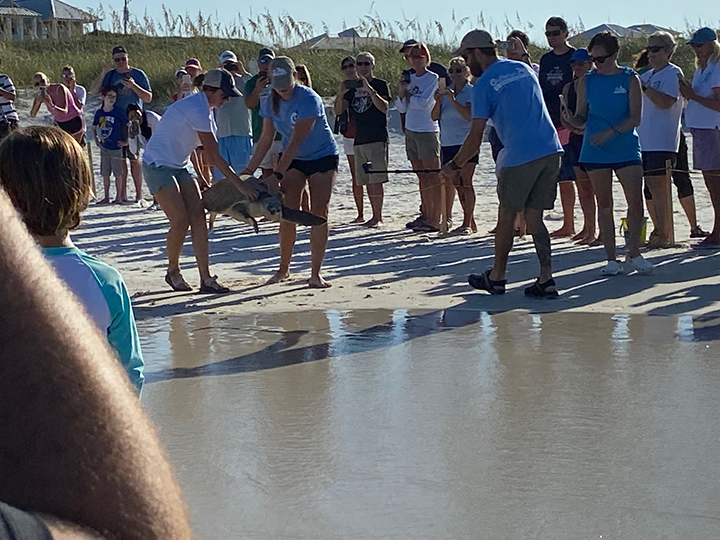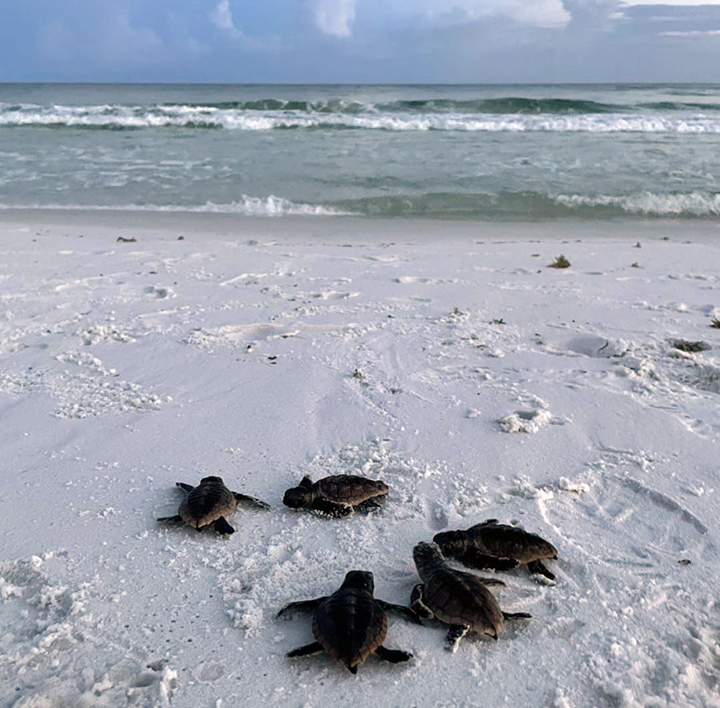Sea turtles are among the oldest creatures on earth and have remained essentially unchanged for 110 million years. We are lucky enough to have them living among us in the Florida Panhandle. It is important to note that all sea turtles in Florida are on the endangered or threatened species list.
The life of a sea turtle
Sea turtles are air-breathing reptiles remarkably suited to life in the sea. Their hydrodynamic shape, large size, and powerful front flippers allow them to dive to great depths and swim long distances. After their first frantic crawl from the nest to the ocean, male sea turtles never return to the shore again, and females come back only long enough to lay eggs.
Sea turtles are threatened in many ways, such as encroachment of coastal development on their nesting beaches, encounters with pollutants and marine debris, accidental drownings in fishing gear, and international trade in turtle meat and products.
When is turtle season in the Florida Panhandle?
In summer, the ancient reproductive ritual begins when the female leaves the sea and crawls ashore to dig a nest in the sand. She uses her rear flippers to dig the nest hole and then she deposits about 100 eggs the size of ping-pong balls. Female sea turtles often appear to be weeping as they nest; the main purpose for these tears is to remove any salt from the turtle's body.
When egg-laying is complete, the turtle covers the eggs, camouflages the nest site, and returns to the ocean. Nesting turtles may return several times in a nesting season to repeat the process and usually nest every two to three years.
Turtle season on the Emerald Coast of Florida occurs from May 1st through October 31st. Nesting occurs between May through August with peak nesting season in mid-June through July. Nests hatch between July and October with peak hatching occurring from late August through mid-September.
What kind of sea turtles do we see most in the Florida Panhandle?
Loggerhead turtles are the most common species of sea turtles in the Florida Panhandle. They are named after their massive heads and strong jaws. Loggerheads are the largest of all hardshell turtles with adults weighing around 250 pounds. They are keystone species, meaning other animals in the ecosystem depend on them for survival.
Green sea turtles are also found in the Florida Panhandle, and they are herbivores, meaning they actually practice green eating. Whether a green sea turtle is born male or female depends on the heat of the sand incubating the eggs. Warmer temperatures produce females and cooler temperatures produce males. They typically live to be around 70 years old and some live up to 100 years old.
Leatherbacks are also seen in the Florida Panhandle and are the largest turtle species in the world without a hard shell. They are named for their tough rubbery skin and have existed in their current form since the age of the dinosaurs. They can be up to 1,300 pounds and 8 feet long!
Hawksbill turtles and Kemp's Ridley turtles are also found in Florida. The Federal Endangered Species Act lists all of the sea turtles in Florida as either threatened or endangered species, meaning they need protection to avoid becoming extinct.
Sea Turtle Nesting and Hatching Behavior
Between 20 to 35 years of age, adult loggerhead and green sea turtles return to the same beach where they were born to build a nest for their young. Mama sea turtles nest far up near the dunes and lay eggs. This takes a few hours for the sea turtle to find the perfect spot. They then dig a hole, lay their eggs, and cover them with sand. Adult females only nest every two to three years making this an important event in maintaining the species. The number of eggs in a nest is called a clutch.
Sometimes the adult sea turtles may make a false crawl. The false crawl is when sea turtles come to shore to lay their eggs but turn around without depositing them onto the sand. There are several reasons for this, such as noises or lights on the beach, beach furniture or trash blocking their way, disturbances by beachgoers, or she did not find a suitable nesting site. If the mother turtle can’t find a safe place to lay her nest, the entire clutch could be lost.
Two months after the nest is laid, hatchlings emerge at night and must quickly reach the water to survive. Sea turtles are born with the instinct to move toward the brightest direction. On a natural beach, this direction is the light of the open horizon. However, beachfront lighting can draw them in the wrong direction. In the Panhandle, we have a high level of hatchling disorientation with hatchlings going towards artificial lighting instead of the Gulf. They are also vulnerable to threats along their journey to the sea. Other animals or even beachgoers can be a threat to these baby sea turtles during this time.
Be sure to follow the Rules For Nesting Season
Clean. Dark. Flat. If you are enjoying the beaches, remember we are in the sea turtles’ natural habitat. It is illegal to handle, harass, or interfere with sea turtles or their nests on the beach or in the water. Following a few simple rules at the beach will ensure the sea turtles are safe and you enjoy a great time at the beach.
Clean: Leave No Trace is something to remember in every instance but especially during turtle season. Keep the beach clean, remove all of your belongings and trash from the beach each night.
Dark: Keep exterior beach visible lights off and blinds/curtains drawn to reduce interior light visibility, reduce flashlight usage, and use red LED flashlights if needed. Turtles are confused by lights on shore which is why darkness is needed.
Flat: Fill in holes and knock down sand castles, this prevents sea turtles from wasting energy struggling as they cross the sand.
You can always help by reducing artificial lighting on the beach, especially if you have noticed a marked nest in the area. Remember, clean, dark, and flat is the best environment for hatchlings. Make sure you keep flashlights off at the beach, close the blinds at sunset, and turn off balcony lights. Please refrain from touching any hatchlings and do not disturb their nest area.
If you happen to see a sea turtle nesting or nest hatching, stay very quiet, keep your distance, and turn any lights off and no flash photography. You should never try to touch a wild sea turtle. Also, do not touch or move any hatchlings. The small turtles need to crawl on the beach to imprint their birth beach on their memory. If you see anyone harassing a sea turtle or a sea turtle in distress for any reason, do not hesitate to call the Florida Fish and Wildlife Commission (FWC) hotline at 1-888-404-3922.
There are numerous local Turtle Watch Programs on our beaches
Turtle watch programs are staffed with dedicated volunteers. Volunteers mark nests, often with caution tape, so that people and animals do not disturb them. Volunteers receive training from Florida Fish and Wildlife Commission (FWC) and other local programs to aid or rescue hatchlings if they are disoriented. They work hard to track turtle nests, cordon them off, and protect and care for the sea turtles until they hatch and enter the sea. Turtles on our beaches are endangered or threatened and in need of our help as we have moved onto the beaches where they nest.
Panama City Beach Turtle Watch is a team effort organized to protect sea turtle nests in northwest Florida. This group of volunteers comes together with a common purpose to locate sea turtle nests, protect them until hatching, and help the hatchlings make it safely to the water. This protection is necessary to improve the survival chances of the turtles since hunting and habitat destruction have greatly reduced their numbers.
South Walton Turtle Watch is a local non-profit conservation organization that holds a Florida Marine Turtle Permit issued by the Florida Fish & Wildlife Commission (FWC). They are permitted to conduct sea turtle nesting surveys on Walton County beaches. They also perform sea turtle nest inventories and respond to sick or injured sea turtles. They strive to protect endangered sea turtles and their nesting habitats so they can continue to thrive and increase the populations of sea turtles.
As an example of their efforts, in the 2023 nesting season, South Walton Turtle Watch marked 56 nests, 43 false crawls, and 2,517 hatchlings. This is an amazing number of mama turtles coming to our shores!
How to volunteer as a turtle watcher
There are many opportunities to donate, volunteer, and adopt a sea turtle. Check out the local turtle watch groups to see how you can get involved in different interactive educational programs, donate, and volunteer. Gulf World Marine Institute allows you to symbolically adopt a turtle aiding in the support and treatment of caring for animals in rehabilitation. Don’t forget to educate your friends on the importance of protecting our sea turtles.
Helping to protect sea turtles is all of our responsibility
Sea turtles are an important part of the marine ecosystem. Along the Florida coast, sea turtles annually make between 40,000 and 84,000 nests. Turtle Watch Programs have been organized to help us track nests so we can better protect them. By understanding sea turtle nesting and hatching behaviors, we can all do our part in protecting these beautiful species.
If you see a stranded sea turtle, call the Florida Fish and Wildlife Conservation Commission (FWC) Division of Law Enforcement at 1-888-404-FWCC or *FWC from your cell phone.

